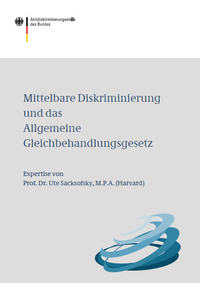Indirect Discrimination
and the General Equal Treatment Act
- Factsheet on the research project -
Authors: Prof. Dr. Ute Sacksofsky, published by the Federal Anti-Discrimination Agency (FADA) Year of publication: 2010
Brief overview
The expert opinion examines the current state of jurisprudence on indirect discrimination. This legal concept of indirect discrimination serves to combat hidden discrimination as well as the often unconscious and historically engrained marginalisation of discriminated groups.
Main results
The great majority of court decisions that are related in any way to indirect discrimination were handed down by labour and administrative courts. In these instances, predominantly public law employment relationships were affected.
Problems, unanswered questions and uncertainties in jurisprudence
The author mentions the following problems and uncertainties that obtain in the case of indirect discrimination:
- The function of the legal concept of indirect discrimination is not always clearly recognisable in the relevant court decisions.
- In some constellations – for example the question of whether unequal treatment based on marriage and same-sex unions is to be considered as direct or indirect discrimination on the basis of sexual identity – the differentiation between direct and indirect discrimination can prove to be very difficult.
- The question also exists as to whether persons who belong to the dominant group are also protected from indirect discrimination, for example in the case of men who work part-time.
- In one decision, the Berlin Labour Court failed to realise that indirect discrimination does not require discriminatory intent.
- In some cases, courts conducted their own comparability test to determine whether or not indirect discrimination had occurred. Such a procedure is to be rejected.
- Statistics can provide valuable assistance in proving indirect discrimination. However, it should be possible to provide evidence in other ways. If statistics are used, the different levels of affectedness must be considerable enough. However, what precisely is meant by ‘considerable’ in this context still remains to be clarified.
- If justification grounds are put forward in cases of indirect discrimination, these are to be subjected to a proportionality test. However, the courts have given very little thought so far to the precise benchmark that needs to be applied.

